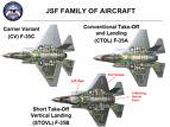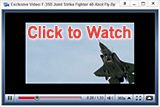Two F-35B Joint Strike Fighter (JSF) test jets flew six times on Wednesday, March 10, above Naval Air Station Patuxent River, Md., clearing the way for the program’s vertical landing tests. One aircraft, flown by test pilot Graham Tomlinson, was a Short Takeoff and Vertical Landing (STOVL) variant of the Lockheed Martin design. It flew multiple hops in close pattern work, with each trip flown at a lower airspeed than the one prior, and with “hot pit refueling” (without shutting down the engine) performed between each flight. For this test, each landing was performed at a higher speed than its associated pattern work and culminated in a 40-knot fly-by followed by a 75-knot landing. The test program of the shaft-driven vertical lift fan and aft vectored thrust system will now move on to vertical landings. While the March 10 flights were uneventful, the politics surrounding the aircraft — the most expensive acquisition in U.S. military history, according to Aerospace & Defense News — continued on March 11 to be more dramatic.
One day after the flight tests, the Pentagon on March 11 told Senators that the average per unit cost of the aircraft has risen from roughly $50 million (in Fiscal 2002 dollars) to $112 million in today’s dollars. Those cost figures presume that more than 2,400 of the aircraft will be purchased, as intended, by branches of the U.S. military. As with any current high-cost government funded project, the JSF program has recently found its share of scrutiny and criticism. Following a recent restructuring of the JSF program, brought on to restore the schedule in the development program, the military now expects to have the jet flying for the Marine Corps in 2012. The Navy’s carrier version will follow in 2014. First JSF squadron deployment is expected in 2016. Foreign F-35B customers include the United Kingdom’s Royal Air Force and Royal Navy, and the Italian Air Force and Navy.
Related Content:
Watch the video




































